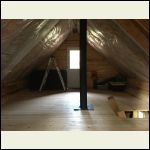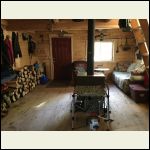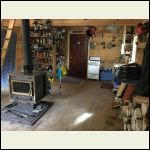|
| Author |
Message |
Aklogcabin
Member
|
# Posted: 19 Jan 2022 12:44
Reply
I was wondering what would take to put a 12vv led powered light system in our cabin. For the last 5 years ago so I have used the same 12v car battery for things and trying to upgrade.
Probably 2-4 lights upstairs. 5-6 scattered around in the lower level. Hopefully not all used at the same time.
I'm thinking of wiring it like you would a house. With lights going through a switch to lights in the ceiling. Or to a lamp.
Using telephone wire. I could run several circuits through the same casing. Using different colors for different circuits with a common ground.
Probably should upgrade the battery to. I know a fellow who works on golf carts n might be able to score a used battery or 2 from him. Would these work ?
I have a 120v battery charger now powered off a generator to charge batteries. But just bought a 2500w duel fuel champion generator. With the little ports on them. What would be the best way for charging batteries ? Off a portable battery charger or off the generator ? How many can I run ?
Or maybe I'm all wrong. My goal is to have 12v lights. Throughout the cabin. Powered off batteries in the generator shed by the generators.
Thanks all
Upstairs
| 
Great room
| 
Kitchen area
| 
Cabin n generator shed
|
|
|
FishHog
Member
|
# Posted: 19 Jan 2022 12:53
Reply
Just be careful that you don't make it look like 110v wiring that someone mistakenly hooks up to.
I ran just like a normal house setup with switches in the wall to 12v LED lights. You can get 12v LED edison bulbs and use normal household fixtures.
Hooked up to my 12v solar system batteries. I also put a lot of pull chain light fixtures so that its easy to turn individual lights on and off. A main switch turns 3 on, but then when I don't need all 3, I can pull cord one or two of them off.
They are 13watt bulbs but normal 100w equivalent. I think they are an awesome addition.
Its no big deal if someone screws a 110v bulb in accidently, but it can be if someone hooks 110 into your 12v system, so make sure that won't happen.
|
|
travellerw
Member
|
# Posted: 19 Jan 2022 13:28 - Edited by: travellerw
Reply
FishHog has the right answer.. Wire it like a 120V system to prevent accidents and future proof.
However, at that point it may make sense to just run 120V LED lighting through an inverter. After you factor loses of the 12V through the wires VS losses in the inverter, its pretty much a wash. Except that the 120V LED lights can be bought anywhere for super cheap now! Plus you can run other 120V things (like a coffee grinder). Then get an auto switch (about $100 on Amazon) so when the generator is started it automatically powers up the plugs and lights, then switches back to inverter when turned off.
As to the generator.. DO NOT use the battery charging port on it. Those are basically for emergency use only as they have zero circuity (just a bridge rectifier that puts out 13.4V). Use a good smart charger with an equalization phase.
|
|
gcrank1
Member
|
# Posted: 19 Jan 2022 14:05 - Edited by: gcrank1
Reply
The genny 12v power taps dont put out enough amps to recharge big capacity bat-banks, use As Much Charger off the ac outlet As Your Bat Chemisty C-Rate can take (and that is within the gen's capacity).
Fla is pretty safe at C-8; ie, 12v 100ah/8 = 12.5amps, a 200ah could take 25amps, etc. But check/verify with the bat manufacturer.
Lfp can do sooo much better, a 100ah can easily take 50amps!
I tried straight 12vdc, combo 12vdc and 120vac and settled on total 120vac. No regrets in over a year now.
And most of last year was powered with 2 old bats, iffy ah's but call it 100ah at best. A new grp 27 100ish ah 'marine deep cycle' would work fine, 2 even better (never a basic 'car bat' unless desperate).
Fixtures are common, inexpensive Edison bulb type with pull chains (no extra switches to buy or install). Our bulbs are Edison looking, 9w/60ish w equiv LED (led, the ONLY way to go). We have 4 fixtures strategically placed but rarely use more than 1. They are sooo efficient that I dont even have to calc them any more! Because they draw so little the wiring does not have to be big, I used common, cheap, easy to work with lampcord.
I use a small pure sine wave (psw, dont get anything else!) 300w inverter, low .5a draw. Even if I leave it turned on all night after we turn everything off I cant see a diff on my dig-vom of the battery. I turn it off just to hopefully extend the life of the unit. And I turn it off during times we arent running anything, thats why it has a switch. BUT, if I were buying today I think Id get it in a 500w size, the amps it would use are so marginal over the 300 that it wouldnt matter and someday the 'extra' capacity might be nice. A small inverter with capacity closer to your load is far more efficient than a way oversized one to run 1 or 2 led bulbs most of the time.
It powers the led lights, a usb port is in it, can charge tool packs, box fans, etc., all the light-duty stuff.
Any big draw stuff is run off the little 1700/2000 inv/gen (big tools, microwave, etc.). Until I was satisfied with my solar array I also had the ac charger hooked up so whenever the gen ran it was charging the bank.
I have the solar, bats and gen at the toolshed/powerhouse 90' away and one 120 line to cabin. I am the transfer switch; start the gen, unplug from the inverter, plug into the gen. The big draw stuff is on its own outlet in-cabin (seperate from the lights) for only when gen runs. If we need the lights I plug them into that outlet. Easy swaps. This way nobody trys to run the MW off the little inverter.
Btw, with a basic battery and small inverter you can easily trial your led light fixture locations by using cheap household extention cords and lamps, probably stuff you have at home now.
|
|
NorthRick
Member
|
# Posted: 19 Jan 2022 15:53
Reply
I'd go 120v AC using an inverter. 120v stuff is cheaper and easier to find. Telephone wire likely isn't thick enough. One 13 watt light at 12v is about 1 amp. 13 watts at 120v is about 0.1 amps. For wire size, it's all about amps.
|
|
FishHog
Member
|
# Posted: 19 Jan 2022 16:42
Reply
I go the other way, I have a dedicated line for my inverter for the odd time I need 120. Typically just recharging my laptop.
all the other time my stuff is 12v and only drawing power when I have a light on.
The other way my inverter would be on 24hrs a day using up idle power for the odd time I need to flick a light on for a couple minutes.
My lights in total would be a couple hours a day max and usually just one 13w light.
Running an inverter 24hrs a day would consume much more power. But that all depends on your needs which are well worth calculating before making a choice on equipment.
|
|
ICC
Member
|
# Posted: 19 Jan 2022 17:27
Reply
Quoting: Aklogcabin Using telephone wire.
No.
You may have noticed in reading that wires have resistance. Long wires cause the voltage at the other end of the battery to drop depending upon how much current is being drawn, the wire gauge and the length of wire.
Most advice is to limit the voltage drop to 3% maximum. When dealing with low voltages IMO, it is even better to limit the drop to 1.5 to 2%.
Telephone wire in common use today is 24 gauge. It used to be 22 gauge. But I just looked and see that the bulk wire at Home Depot is now 25 gauge, a touch smaller than 24. (As numbers get bigger the wire size gets smaller, FYI).
Humph. My g-voltage drop calc doesn't go to small enough gauges to use. So I found an online one that does. It is here. You can use it to figure different things.
I have lots of 12 VDC led lights in by bus/rv. some under cabinet lights that get used a lot have the following specs: 18" length, 12 volts, 9 watts, 800 lumens and 0.37 amps. To wire one of those up with 25 gauge phone wire and keeping the voltage drop to 2% gives me 3 meters of wire (15 feet) from battery to light.
If you want to run just some led lights start by finding lights you could use. How many lumens do you need? Compare the lighting you use in the home where you live. Would that work? Would less lumens work? Or not? Once you know the lumens needed then go looking for lights that could be used. Look at the specs to see the amps or watts needed for that light. (watts divided by volts = amps). Run the wire gauge / voltage drop calculator.
You will likely find that you would need bigger wires to run to every light location you want.
Running 14 gauge romex makes a lot of sense. BUT, IMO, you should not run any AC wires through the walls if you are running romex for DC use. It may be easy enough for you to remember what is 120 VAC and what is 12 VDC, but if you get old enough you may forget. A mistake could be deadly. I would advise going all 12 VDC or all 120 VAC, OR using wire for the 12 VDC that could not be confused with AC. But not telephone wire.
Doing it as FishHog did can be a good compromise for a cabin IF one's 120 VAC needs or wants are very limited.
|
|
DartNorth
Member
|
# Posted: 26 Jan 2022 20:46
Reply
Wire it up for 110V. Wire it as you would if you were on grid, to code (or as close as possible). Use a low ghost draw 110v inverter. We use a 300W go power pure sine inverter. It's about 7 amps draw per 24 hours. The led bulbs in our lights are all 8-12 watts. We have outlets to plug in small appliances. Can switch over to generator for larger appliances, tools, etc.
Better yet, get an auto transfer switch to make switching from inverter to generator even more convenient. We went with GoPower again for that and got the TS-30. It powers from the inverter until the generator is started, then switches over automatically. So quickly, it doesn't affect electronics.
For charging, get a proper 4/5 stage charger. Size it based on your battery bank. If you have an auto charger already, that will work as well, and is usually faster/higher amperage than what comes out of the generator. Plus, some generators will only output either 12v or the 110V, and not both. With a separate charger, can charge while running other 110v stuff.
|
|
|
gcrank1
Member
|
# Posted: 26 Jan 2022 21:04
Reply
Have you seen the 'Edison looking' led solar bulbs? I bought the 3-pack off Amazon (about $30), came with a small solar panel and long wiring that is a mini-usb into each bulb. Each also has a small push switch and hanging hook. They will also charge off a wall-wart.
I keep them in reserve for back-up or a portable to take and hang/hold where I have no lights   . .
If I had just a simple camp or cabin Id probably just use them instead of putting in a whole system and wiring. Too Easy!
|
|
Brettny
Member
|
# Posted: 27 Jan 2022 04:37
Reply
I wouldnt mess with a separate 12v light system now a days. As for the standby losses of a inverter..if you cant get by 1 or 2 days with just the inverter losses your system is to small. If your trying to keep more power in your battery just add another solar pannel. Pannels are prety cheap now and even cheaper used.
If your car battery is 5yrs old I would say it's far outlived its life as a solar battery. First thing I would do is upgrade that.
|
|
FishHog
Member
|
# Posted: 27 Jan 2022 07:14
Reply
Quoting: Brettny if you cant get by 1 or 2 days with just the inverter losses your system is to small
Unless you live further north and get way less sun in the shoulder seasons. I went 10 days with no sunshine this fall. Solar was putting out about 1amp at best.
I was in full energy conservation mode, but made it through.
Point is everyone is different with their need and location, so plan properly for your needs.
|
|
Provolone
Member
|
# Posted: 22 Jan 2024 08:01
Reply
I did something similar in my cabin with 12v LED lights. I started with a car battery and switched to a better one, like the golf cart batteries you mentioned. Those should work just fine.
I picked Simba Lighting LED MR16 3.5W 12V bulbs for my place. They're bright and don't use much power, which is perfect for both cabin floors. I set them up with switches like in a typical house, and it's been working great.
|
|
Outbuilding Info
Member
|
# Posted: 22 Jan 2024 10:37
Reply
This is interesting to me. I spoke with our solar installer the other day and he recommended both for and against DC power. For small (LED lights), continuous (fridge) loads, he was all for DC power. The inverters are far less efficient when running at low power compared to the rating. This happens when, for instance a fridge is the only thing running when you are away but it only draws a fraction of the inverter's capacity.
His recommendation was to use DC in these cases (including the fridge) but that he rarely uses 12V due to the line loss as others have mentioned. Instead, he recommends 24V or even 48V.
This may not fit your current or future plans, but his advice made good sense if you are able to spec a new system.
|
|
paulz
Member
|
# Posted: 22 Jan 2024 10:56 - Edited by: paulz
Reply
Interesting thread.. My place has gone through a decade of power and lighting changes but not progressed all that much! One thing I haven't seen mentioned is 5v USB powered LEDs, of which I have many. My longest run is from the 12v bank to the bathroom, about 30'. And yes, wire size is critical, that one has a battery (an old outside motion LED) that will run for about 15 minutes without usb connection, and it surely takes it's time keeping the battery up when on the usb. I do have a 12v ceiling light in the main room, and the 110v ceiling fan has lights, which I never turn on.
So, AC LEDs use less juice? I don't use my inverter often, and at 2,000 watts it's really too much for lighting. No idea what it draws stand alone but I'll check.
Ak, it's funny how similar our cabins look inside. One difference is your similar wood stove is in the middle of the room, which probably helps where you are, while mine is along a wall. I did put a fan in mine (USB powered) that circulates the heat.
|
|
gcrank1
Member
|
# Posted: 22 Jan 2024 11:54
Reply
I use a 300w psw inverter for our led lighting, fans (including a cheap house type ceiling fan), usb charger and have also plugged my cordless power tool recharger in. The inverter uses so little power, and my led lights so little, that I dont even really calc them into my use profile any more.
Using 120vac and small extension cords for the led lights was so much better than running 14 or 12ga romex for lighting (btdt, never again for leds).
We also gave up on running a fridge for our 'recreational' cabin; it required too big a system to make sense to me. A Yeti clone ice chest has been just fine (gotta use one right) with our home freezer bottle ice packs.
|
|
Grizzlyman
Member
|
# Posted: 22 Jan 2024 15:16
Reply
I’ve gone 3 summers now with just a 12v battery and a cheap Amazon panel. I didn’t see a need to overcomplicate lighting. I have 7 lights, a led light strip, and a led outdoor bulb string on the patio. I also have a couple usb chargers, a usb fan, and a big 12v RV ceiling fan.
The fixtures are proper nice 120v fixtures with 12v LED bulbs screwed in. I did use special 12v switches as I had read it matters due to the nature of low-voltage and good contact being necessary. They are nice switches though- not something that looks like it’s from RadioShack.
Everything is wired with THHN. I can’t recall but I think 10 gauge handles the load just fine depending on run length. My longest runs were around 50 ft. THHN is not too expensive either, and very flexible.
I think the bulbs are like 6W… which means 6/12=~1/2 amp each. 1/2x 7 lights=3.5 amp/hour. Plus the string lights… call it 4… even giving the benefit of the doubt call it 5 amps for the whole cabin per hour.
An 80 amp hour battery should be able to run the entire cabin for 16 hours. (I know the math gets wonky based on discharge rate- but close enough).
Of course you never use ALL the bulbs… and even if you do it’s only for 3-4 hours per night in the summer…so realistically it’s several days to a week of runtime on one battery charge.
So far this has worked well for three years. I did run into trouble this fall as the lights are needed for a longer time in late October and the sun is scare. It’s dark by 5-6 and not light until 7-8 in the forest. And Even when it was sunny, it is at a lesser angle meaning less amperage to charge. I still used it with barely any sun for 3 weeks though, though did have a night where we ran out… but it was like 11pm anyways. When it ran out it still powered 1 bulb at a low-light setting. I’m fine with just one battery, but 2 batteries would be foolproof.
I just disconnect the panel and cabin when I leave as I don’t want the hassle/risk of something going wrong. Simple.
|
|
Brettny
Member
|
# Posted: 23 Jan 2024 09:14
Reply
I did some testing with 12v flush mount recessed lights. What I have gathered is there very dim yet some are brighter than others. Very inconsistent light output and thus not that reliable. I was really going to run 12v lights in each room now I'm looking more at 120v lighting.
|
|
gcrank1
Member
|
# Posted: 23 Jan 2024 09:49
Reply
I started with 12vdc, then a combi of 12v and 120v. The best 12v bulbs I used were MR16, and they didnt require heavy wiring. I had some spot and flood lights, the floods were better for my use. I made a few conversion fixtures that were 'cabinish' to hold them.
Since I had to run wires anyway it turned out far better for me to just go to to 120vac, standard fixtures and switches and Edison base 120v led bulbs.
I even went to 120vac off a small msw inverter in my toolshed. I go in, flip the inverter switch and have lights and usb charger. The bat is an old small 20ah sealed lead acid hooked to a small solar panel inside a south window. Had all the stuff laying around from early learning attempts......
|
|
darz5150
Member
|
# Posted: 23 Jan 2024 10:03
Reply
I am wired for both ac/dc.
There really isn't much difference in light output from 1 4 foot led 2 tube ac compared to the 2 12 volt screw in bulbs.
|
|
gcrank1
Member
|
# Posted: 23 Jan 2024 15:36
Reply
It all in the 'lumins', we have to forget the old 'watts' rating of incandescent bulbs.
Then it is the type of light they throw, bright white or warm white, etc., the warmer ones are lots easier on my eyes, the bright are like landing lights.
|
|
Brettny
Member
|
# Posted: 23 Jan 2024 18:40
Reply
Lumens..yes.. but then you get the sellers/manufacturer that lies about this and its prety hard to test.
|
|
gcrank1
Member
|
# Posted: 23 Jan 2024 19:51 - Edited by: gcrank1
Reply
Yeah,,there is that....
My 'solution' is that if a bulb says it is a (for instance) 9w led = a 60w incan then Id go to a 12.
|
|
|

